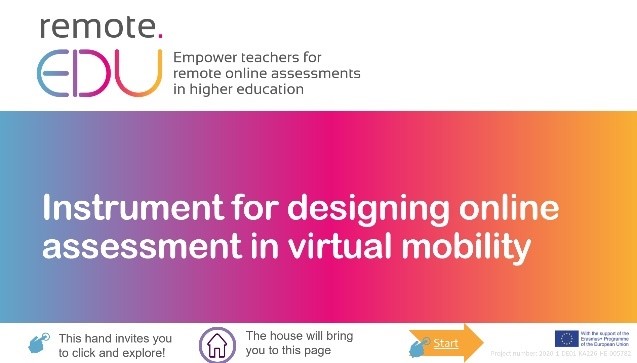IO4 Instrument for Designing Online Assessment in Virtual Mobility
The starting point for using this instrument is that you have chosen to design a virtual mobility course or activity and that the different virtual mobility formats are known. The guidance in assessment design in this instrument focuses only on online assessment for learner skills within the VM Competence Framework (Rajagopal & Firssova, 2020).
What is it?
The instrument for designing online assessment in virtual mobility is a reflective step-by-step guide that is aimed at orienting in choosing an appropriate assessment method in the online assessment design for learner skills in virtual mobility (VM).
Whom is it for?
The instrument can be used by administrators with a broad focus on educational design (e.g., educational designer/developer, international relations officer, educational technologist, etc.) in supporting instructors/instructor teams, as well as the instructors/instructor teams themselves in the development of their course/educational programme within Virtual Mobility.
For a detailed overview of the different online assessment methods (incl. description, taxonomy levels and cohort size, suggestions for implementation and handling fraud, practice examples), download the following documents:
Introduction to Virtual Mobility
Virtual mobility is defined as “the set of ICT supported activities, organised at institutional level, that realise or facilitate international, collaborative experiences in a context of teaching and/or learning”.
Virtual mobility has become a key strategic theme in the European Higher Education Area, with the establishment of virtual mobility tracks within the Erasmus Student Exchange and the promotion of university networks that aim to facilitate virtual exchanges. These strategic advances build on decades of projects on this concept as a means of broadening internationalisation in education, taking advantage of the technical possibilities offered by digitalisation.
In the IO4 output, we have looked at the needs for online assessment within the context of virtual mobility. Explore in the video why you should invest in virtual mobility and learn about the four formats of virtual mobility that can be distinguished.
Interesting sources for designing virtual mobility courses
- The VM Design Guide explores in detail all aspects of the learning environment and the overall design of your virtual mobility course.
- Rajagopal, K., Brouns, F., Firssova, O. & Op de Beeck, I. (2020). Open VM Design Guide. Retrieved from https://www.openvirtualmobility.eu/open-credentials/4412-openvm-design-guide
- The VM Learner Competence Framework was constructed building on the answers of 49 experts in Virtual Mobility and Open Education and resulted in a framework of competences that can be achieved in conducting virtual mobility courses.
- Rajagopal, K. & Firssova, O. (2020). Open VM Learner Competence Framework (English). Retrieved from https://www.openvirtualmobility.eu/outputs/4407-openvm-learner-competence-framework-en
- Download the Template Learning Support (DOCX) for module 4 of the remote.EDU open online course on online assessment. Module 4 introduces you to online assessment in international contexts and virtual mobility
- Access to the Online Course

